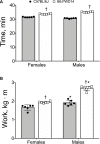Contribution of Chromosome 14 to Exercise Capacity and Training Responses in Mice
- PMID: 31572215
- PMCID: PMC6753330
- DOI: 10.3389/fphys.2019.01165
Contribution of Chromosome 14 to Exercise Capacity and Training Responses in Mice
Abstract
Quantitative trait loci for exercise capacity and training-induced changes in exercise capacity were identified previously on mouse Chromosome 14. The aim of this study was to further investigate the role of Chromosome 14 in exercise capacity and responses to training in mice. Exercise phenotypes were measured in chromosome substitution strain mice carrying Chromosome 14 from the PWD/PhJ donor strain on the genetic background of a host C57BL/6J (B6) strain (B6.PWD14). Eight week old female and male mice from both strains completed a graded exercise test to exhaustion to assess intrinsic or baseline exercise capacity. A separate group of 12-week old female and male mice, randomly assigned to sedentary control (SED) or exercise training (EX) groups, completed a graded exercise test before and after a 4-week exercise training period. EX mice completed a 4-week training program consisting of treadmill running 5 days/week, 60 min/day at a final intensity of approximately 65% of maximum. For intrinsic exercise capacity, exercise time and work were significantly greater in female and male B6.PWD14 than sex-matched B6 mice. In the training study, female B6.PWD14 mice had higher pre-training exercise capacity than B6 mice. In contrast, there were no significant differences for pre-training exercise capacity between male B6 and B6.PWD14 mice. There were no significant strain differences for responses to training. These data demonstrate that PWD/PhJ alleles on Chromosome 14 significantly affect intrinsic exercise capacity. Furthermore, these results support continued efforts to identify candidate genes on Chromosome 14 underlying variation in exercise capacity.
Keywords: chromosome substitution strain; genetic; inbred mice; quantitative trait loci (QTL); sex differences; treadmill running.
Copyright © 2019 Massett, Courtney, Kim and Avila.
Figures


Similar articles
-
Effect of chromosome substitution on intrinsic exercise capacity in mice.F1000Res. 2014 Jan 13;3:9. doi: 10.12688/f1000research.3-9.v2. eCollection 2014. F1000Res. 2014. PMID: 25184035 Free PMC article.
-
Exercise Capacity and Response to Training Quantitative Trait Loci in a NZW X 129S1 Intercross and Combined Cross Analysis of Inbred Mouse Strains.PLoS One. 2015 Dec 28;10(12):e0145741. doi: 10.1371/journal.pone.0145741. eCollection 2015. PLoS One. 2015. PMID: 26710100 Free PMC article.
-
Congenic strains of mice for verification and genetic decomposition of quantitative trait loci for femoral bone mineral density.J Bone Miner Res. 2003 Feb;18(2):175-85. doi: 10.1359/jbmr.2003.18.2.175. J Bone Miner Res. 2003. PMID: 12568393
-
Quantitative trait loci for exercise training responses in FVB/NJ and C57BL/6J mice.Physiol Genomics. 2009 Dec 30;40(1):15-22. doi: 10.1152/physiolgenomics.00116.2009. Epub 2009 Sep 29. Physiol Genomics. 2009. PMID: 19789284 Free PMC article.
-
Confirmation of provisional quantitative trait loci for voluntary alcohol consumption: genetic analysis in chromosome substitution strains and F2 crosses derived from A/J and C57BL/6J progenitors.Pharmacogenet Genomics. 2008 Dec;18(12):1071-82. doi: 10.1097/FPC.0b013e32831367f0. Pharmacogenet Genomics. 2008. PMID: 19008751
References
-
- Blair S. N., Kohl H. W., Barlow C. E., Paffenbarger R. S., Gibbons L. W., Macera C. A. (1995). Changes in physical fitness and all-cause mortality. A prospective study of healthy and unhealthy men. JAMA 273 1093–1098. - PubMed
LinkOut - more resources
Full Text Sources
Molecular Biology Databases

